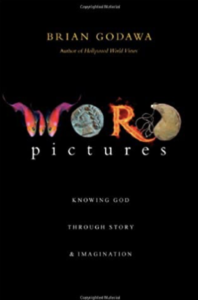
Hollywood Worldviews: Watching Films with Wisdom and Discernment

Word Pictures: Knowing God Through Story and Imagination
As both an industry insider and a Christian scholar, Brian Godawa’s situation is unique and vital to both a Christian understanding of culture and a cultural understanding of Christianity. From this tenuous place Godawa delivers his critique of Hollywood’s treatment of Christians and Christian subject matter, but he tempers it with a call for a deeper understanding and appreciation of cinematic storytelling. Producer Ralph Winter ’s foreward to Hollywood Worldviews points out the gap between the Christian worldview and the messages espoused by the vast majority of Hollywood stories, citing that there are “not many places where deep dialogue can happen on postmodernism and Indiana Jones” (9). Godawa’s cal lfor such dialog aims to reconcile visual storytelling through cinema and the cultural industry of movies and is well warranted. In fact, it is long overdue.
Godawa’s approach focuses upon the ideological aspects latent in both narrative form and film. To identify these aspects, he uses the term “worldview” which he defines in James Sire’s words as “‘a set of presuppositions … which we hold … about the basic makeup of the world’” (21). In addressing this aspect of storytelling immediately, Godawa gets to the heart of the conversation that is necessary concerning cinema. In the preface to Hollywood Worldviews, he states that “This book is not a call to praise or condemn films simply because of their ‘message.’ Rather, by learning to be more aware of worldviews, we will be more equipped to appreciate the finer elements of what is going on in our movie-watching experience” (17).
Godawa first lays the groundwork for this task by attempting to dispel fears about the content of film. Chapter 1 is entitled “Sex, Violence & Profanity” and lays out a compelling comparison of the depiction of questionable acts in film and also in the Bible. He writes, “We must be careful in our appeal to the Good Book when analyzing the morality of stories. For in its pages are detailed accounts and descriptions of every immoral act known to humanity” (33). The sections of the chapter cover examples of violence, sex, profanity, and the biblical call for truth, honor, and purity. At times his selection and application of Scripture is too selective and subjective, but Godawa’s point is well made.
Godawa spends more time with story and myth in “Act 1” and moves on to addressing films from different worldviews in “Act 2.” He offers concise but accurate descriptions of existentialism, postmodernism, and several other key ideologies. “Act 3” moves to a discussion of spiritual worldviews. The book ends with Godawa’s reiteration of a call to watch with discernment, which contains nuggets of wisdom such as, “Rare is the film that can be fully embraced in all it communicates” (253).
Godawa’s sojourn into the cultural gap between Hollywood and Christianity is welcome, but it is not without complications. Because there is a gap, the intended audience of the book is a bit ambiguous. The prose style, point of view, and word choices suggest that Hollywood Worldviews is aimed at a Christian audience. The end of each chapter also contains discussion questions, indicating its applications for a youth or small group setting. However, there is also an evangelistic bent to the work. The foreward by a high-profile Hollywood producer is meant to give credence with not only the Christian community, but also the film community. The text is not only for people who “love God,” but also those who “love movies.”
Writing about movies is a tricky thing. Cast a broad net, and the author is too general. State your target audience or objective, and the text seems limited or biased. Godawa attempts to address this difficulty by using disclaimers. In his final chapter he admits:
Even in this book I have struggled with this balance [of discussing positives and negatives]. Because of the constraint of space, I have tried to focus on movies that illustrate a particular point, good or bad, without examining the counterpoint. One unintended result may be the appearance of unqualified approval or disproval of a movie. Be careful not to jump to this conclusion (251, 252).
The problems with this statement are twofold. First, it alienates any non-Christian film critic who can now dismiss the work as shallow and irrelevant. Second, it seems to indicate that the readers Godawa wishes to influence should do what he says and not what he does. While the calls for discernment and understanding of narrative from different perspectives are extremely salient, Godawa’s practice of over generalizations nearly negates this call. For instance, dotting the text are titled lists of movies with categories like “Movies with Negative Consequences of Sin,” “Gratuitous Gore in Film,” and “Movies that Feature Vigilante Justice” (54, 55). The film titles that populate these lists are subjective choices at best.
But if the author wants non-Christian movie fans to see films from a Christian perspective, they may only see Godawa’s defense mechanisms. Godawa’s place inside and outside the culture is tenuous, and his work reflects the love/fear dichotomy. The problem is that this dichotomy is at times defensive and argumentative, which is neither a loving nor effective means of communicating. Godawa confesses and addresses this issue in his next book.
In Word Pictures, Godawa expands on the theme of narrative in the Bible as he tackles an argument that “word and image, reason and imagination, must have equal ultimacy in our understanding of God” (8). The thesis is followed by an explanation of the integration of graphics into the text and a call to “not quickly pass over these images but take time to ‘read’ them as part of the text” (8).
In the first chapter, the author confesses his personal bent towards rational argument and that his search for the deeper truths about God using reason and logic were “becoming dehumanizing.” Godawa states, “I was treating the human being before me as a mere carrier of a set of beliefs that it was my purpose to dismantle into absurdity—all in the cause of ‘leading every thought captive to Christ’” (17). This chapter is the most touching in the text. Those that follow are insightful, but only as one sees that they are still the arguments of a Christian on a journey to prove something.
In the closing chapter Godawa admits, “I have continued on my journey to seek a better balance between my … reason and emotion … I don’t consider myself as having arrived or even living out my revelations as consistently as I would like [sic]” (183). Word Pictures recounts the first-person journey of a Christian trying to prove something to himself. The negative consequence is a pervading taste of hypocrisy. The positives that far outweigh this are the universality of Godawa’s struggle, his honest approach, and the myriad of insights along the way. Word Pictures has the potential to become a touchstone book for a generation of Christian artists and thinkers in a postmodern world.
The individual chapters that make up Word Pictures are in most cases tangential arguments that stray from Godawa’s first purpose to celebrate both word and image. Chapter 6, entitled “Subversion,” is almost entirely an exegesis of Paul’s Mars Hill discourse. This long-winded example is a wonderful study of that speech but somewhat anti-climatic as it is applied to modern cultural works. Godawa builds up the argument that Paul is using Greek cultural reference and rhetorical style to prove a Christian point. He then states, “Here is where the subversion of Paul’s storytelling rears its head, like the mind-blowing twist of a movie thriller” (131). Then Godawa offers only a quick summary of Paul’s conclusion. The language seems to entice the reader to see the Bible’s stories with all the emotional impact of movies. Point taken. But in his writing, even some of the biblical accounts seem to contain flash-in-the-pan effects designed to titillate instead of engage.
Very often, however, Godawa’s arguments are pointed but true. He shines as he points out the “double standard that evangelicals hold in their rejection of other violent or profane movies that are equally redemptive” when he discusses The Passion of the Christ in chapter 5, “Incarnation” (97). The section on Christ as “word made flesh” (100) deals more with the story versus rhetoric aspect of the book, and less with the theme that images are equally important to words. Here Godawa also makes best use of the images integrated into the text. Chapter 4, “Iconoclasts,” is also an insightful digression on the historical evangelical aversion to pictures. The chapter is entirely without graphics, doubtless on purpose, but many chances to “redeem” images were lost in making the point. In general, the integration ofi mages is an excellent approach to illustrate, literally, Godawa’s theme. However, the vast majority of images are Albrect Dürer prints, movie posters, and what appears to be mediocre clip-art. The author’s points are solid, and his prose style passable. His visual style is not without sophistication, but collaborating more closely with a graphic artist may have better fulfilled his idea.
Other chapters include “Word Versus Image” (with the predictable but necessary mention of the Temple artists Bezalel and Oholiab), “Cultural Captivity” (which discusses the subversion of Roman and Jewish culture in the New Testament), and “What Art Would Jesus Do?” (where Godawa’s point about the R-rating of the Bible is made again, and he references Hollywood Worldviews). Each chapter is a separate set of arguments dealing with Christianity, the Bible, and culture. Some relevancy is clear; most of the writing illustrates that Godawa is pointing this rhetorical argument at himself. He confesses his tendency toward this in the opening chapter, and one should know that while Godawa wants the reader not to look at the Bible as a set of arguments, he is going to demonstrate his point using rhetorical speech. The appendix, entitled “Answering Objections,” assumes there will be objections, and that the book is indeed a rhetorical discourse. If balance is as balance does, Godawa admits he is still finding the balance, but the reader should be aware that balance is not yet achieved.
We should welcome Godawa’s cultural criticism. His aims are noble, and his insights many. The merit of both books is their aim at driving discussions deeper, and their calls to re-think presuppositions. Godawa’s voice is confrontational at times, but perhaps this is necessary for some readers to engage in study. The problem may be that the lack of finesse alienates by creating generalities and double standards that both books set out to overcome. By entering into rhetorical debate, Godawa seems to call for rebuttal, creating a closed dialogi nstead of an open one. The reader can, in spite of this, be called to a deeper understanding of stories, both biblical and cinematic, by use of reason and imagination.























